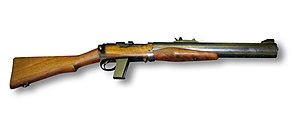De Lisle carabiner
| De Lisle carabiner | |
|---|---|

|
|
| general information | |
| Country of operation: | United Kingdom |
| Developer / Manufacturer: | Sterling Engineering Co. Ltd. |
| Manufacturer country: | United Kingdom |
| Production time: | 1943 to 1945 |
| Model variants: | Standard / Paratrooper (folding stock) |
| Furnishing | |
| Overall length: | Wooden shaft: 930 mm, metal folding shaft : 890 mm |
| Weight: (unloaded) | Wooden stock: 5.75 kg. Metal folding stock: 3.18 kg |
| Barrel length : | 220 mm |
| Technical specifications | |
| Caliber : | .45 ACP |
| Possible magazine fillings : | 7 cartridges |
| Ammunition supply : | Bar magazine |
| Number of trains : | 7th |
| Twist : | right |
| Closure : | Cylinder lock with bolt handle |
| Charging principle: | Repeater |
| Lists on the subject | |
The De Lisle carbine was a British sound-suppressed repeating rifle designed for special forces and short combat ranges. Less than 110 weapons of the type were produced.
history
The engineer William George de Lisle designed the carbine with an integrated silencer for British commandos , which was built from 1941 by the Royal Small Arms Factory (RSAF) . The weapon was mainly used in France and North Africa .
The Lee Enfield rifle , the American Thompson 1928 A1 submachine gun and the Colt M1911 A1 self-loading pistol were used as templates for the weapon . The bolt was taken over from the rifle, the barrel from the submachine gun and the magazine and magazine guide from the pistol . However, all parts were modified in such a way that they were no longer interchangeable with the original weapons.
With a magazine capacity of seven cartridges , the weapon fired .45 ACP pistol ammunition . In some cases, however, stronger charges than usual were used. With standard ammunition, the firing bang is said to have corresponded to that of an air pistol, with stronger ammunition, for example, that of a small-caliber weapon.
This was achieved by a 381 mm to 445 mm long silencer with a diameter of 44 mm, which is divided into two chambers. In the front chamber there are ten metal discs that are bent like a worm wheel and guided on two metal rods.
A total of 500 carbines were ordered by the military, but production stopped after only 106 weapons were shipped.
literature
- John Walter: Rifles of the World , KP Books, 2006, ISBN 978-0896892415
Web links
Individual evidence
- ^ John Walter: Rifles of the World ISBN 978-0896892415 , p. 99
